There are 29 different types of snakes in Nebraska, 25 of which are non venomous and 4 are venoumous.
Whether you need a herping guide for your next trip through the Cornhusker State or you’re looking to purchase a new pet, this list should prove beneficial when it comes to knowing the ins and outs of the different snakes that live in Nebraska.
Table of Contents
Snakes in Nebraska
1. Brown snake
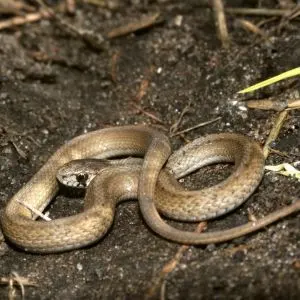
- Experience level: Beginner
- Family: Colubridae
- Scientific Name: Storeria dekayi
- Other Names: De Kay’s snake
- Adult Size: 9-13 inches (22.86-33.02 centimeters)
- Lifespan: ~7 years
- Average Price Range: $30
As their name suggests, the brown snake is typically brown or another darkish coloration. They also have light-colored stripes bordered by black dots. The top of their head is usually black with one or two dots around the neck area.
Residing only in the southeastern portion of the state, brown snakes can be found under logs, boards, or rocks and sometimes in dump sites. Their diet consists of earthworms, snails, and slugs.
2. Bullsnake

- Experience level: Intermediate
- Family: Colubridae
- Scientific Name: Pituophis catenifer
- Other Names: Farmer’s friend, Gophersnake
- Adult Size: 40-70 inches (101.6-177.8 centimeters)
- Lifespan: Up to 12 years
- Average Price Range: $200-$250
The bullsnake is Nebraska’s largest snake as it can get up to almost six feet long. If you run across one of these in the wild, don’t confuse it for a rattlesnake. That’s exactly what they want you to think!
These ground-dwelling constrictors purposefully flatten their head, coil, strike, and hiss loudly in order to give off the appearance of a rattlesnake. The two species also share a similar coloration as bullsnakes are typically yellow with black or reddish-brown blotches.
Bullsnakes inhabit sandy prairies and grasslands throughout the entire state of Nebraska. They feed on rodents, rabbits, and birds.
3. Coachwhip

- Experience level: Expert
- Family: Colubridae
- Scientific Name: Masticophis flagellum
- Other Names: N/A
- Adult Size: 40-60 inches (101.6-152.4 centimeters)
- Lifespan: 12-20 years
- Average Price Range: $100
The color of a coachwhip is contingent on where in the state it’s found. In eastern Nebraska, coachwhips are mostly dark brown or black with lighter brown tails. In western Nebraska, their entire bodies tend to be light brown.
Coachwhips can be found in grasslands, savannas, and sagebrush prairies. They, like the eastern racer, actively hunt with their heads above the ground. Coachwhips mainly feed on small mammals, birds, lizards, other snakes, and turtles.
4. Common garter snake
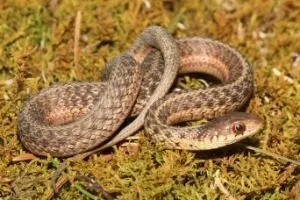
- Experience level: Beginner
- Family: Colubridae
- Scientific Name: Thamnophis sirtalis
- Other Names: Red-sided garter snake, eastern garter snake
- Adult Size: 22-32 inches (55.8-81.28 centimeters)
- Lifespan: 8-10 years
- Average Price Range: $30
Common garter snakes are, well, common throughout the state of Nebraska. They’re typically black, brown, or gray with a yellow stripe running down the back. They also have a black and red checkerboard pattern on each side of their stripe, which is why they’re often referred to as a red-sided garter snake.
Common garter snakes occupy a wide range of habitats, from moist grassy areas to suburban areas, and have a diet of fish, amphibians, worms, and small mammals.
5. Gossy snake

- Experience level: Intermediate
- Family: Colubridae
- Scientific Name: Arizona elegans
- Other Names: Faded snake
- Adult Size: 25-40 inches (63.5-101.6 centimeters)
- Lifespan: Up to 20 years
- Average Price Range: $40
The eastern glossy snake is normally gray or brown with black blotches down the back. Their scales are quite glossy, which is how they got their name.
These snakes can be found in different prairies throughout three Nebraska counties (Dundy, Hitchcock, and Thomas). They feed on small mammals and lizards.
6. Eastern hognose snake
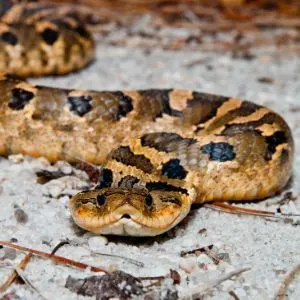
- Experience level: Beginner to Intermediate
- Family: Colubridae
- Scientific Name: Heterodon platirhinos
- Other Names: Puff adder, hissing sand snake
- Adult Size: 20-40 inches (50.8-101.6 centimeters)
- Lifespan: ~12 years
- Average Price Range: $130
The first of two hognoses that live in Nebraska, the eastern hognose snake resides sporadically throughout the eastern portion of the state. Hence its name, this species has a pig-like nose that’s used for digging in sandy soils.
The coloration of the eastern hog nose snake varies (black, brown gray, yellow). Some eastern hognoses have darker blotches down their back while others are pattern-less. They feed solely on amphibians.
7. Eastern racer
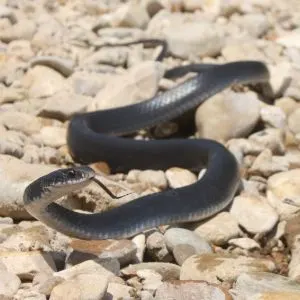
- Experience level: Expert
- Family: Colubridae
- Scientific Name: Coluber constrictor
- Other Names: Runner
- Adult Size: 25-55 inches (63.5-139.7 centimeters)
- Lifespan: 15-20 years
- Average Price Range: $40-$80
This speedy snake is normally green or blue and lives throughout the entire state of Nebraska. Preferred habitats include grasslands, agricultural areas, woodlands, and sometimes manmade buildings.
The eastern racer’s diet revolves around small birds, small mammals, lizards, insects, and other snakes.
8. Graham’s crayfish snake
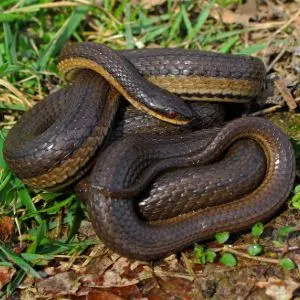
- Experience level: Intermediate
- Family: Colubridae
- Scientific Name: Regina grahamii
- Other Names: Gray crayfish snake
- Adult Size: 26-32 inches (66.04-81.28 centimeters)
- Lifespan: ~7 years
- Average Price Range: $50
Naturally, the primary food source for Graham’s crayfish snake is crayfish. This bicolored species is typically light brown, olive green, or gray on top and white on the bottom. These snakes live in different kinds of watery areas in southeast Nebraska.
9. Great Plains rat snake
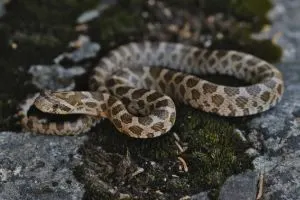
- Experience level: Intermediate
- Family: Colubridae
- Scientific Name: Pantherophis emoryi
- Other Names:
- Adult Size: 24-46 inches (60.96-116.84 centimeters)
- Lifespan: Up to 20 years
- Average Price Range: $80
The Great Plains rat snake can be found in the southeast and central counties that border Kansas. The coloration of this species is light brown or gray with darker blotches on its sides and back.
These snakes generally live in grasslands and avoid wooded areas. They feed on small mammals and birds.
10. Lined snake
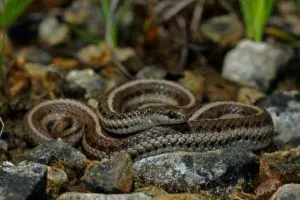
- Experience level: Beginner
- Family: Colubridae
- Scientific Name: Tropidoclonion lineatum
- Other Names: N/A
- Adult Size: 8-12 inches (20.32-30.48 centimeters)
- Lifespan: 3-10 years
- Average Price Range: N/A
The bulk of Nebraska’s lined snakes can be found in areas that border the Platte River. Similar to a garter snake, lined snakes are brown or gray with a light stripe going down the back. This species is fond of prairies and savannas and feed exclusively on invertebrates.
11. Milk snake
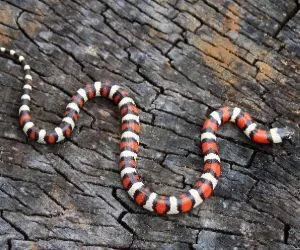
- Experience level: Beginner
- Family: Colubridae
- Scientific Name: Lampropeltis triangulum
- Other Names: Chicken snake, kingsnake
- Adult Size: 24-30 inches (60.96-76.2 centimeters)
- Lifespan: 10-15 years
- Average Price Range: $60-$120
Milk snakes can be found all over the state of Nebraska. These snakes look very similar to the extremely venomous coral snake. However, coral snakes don’t reside in Nebraska, so if you see a snake with red, black, and creamy bands, it’s a nonvenomous milk snake.
Their diet mainly consists of small mammals, small birds, and other small snakes. Milk snakes also make for fantastic pets.
12. Northern watersnake
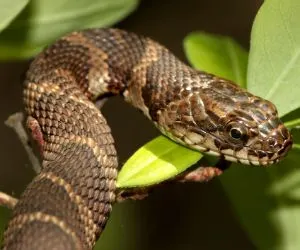
- Experience level: Intermediate
- Family: Colubridae
- Scientific Name: Nerodia sipedon
- Other Names: Common watersnake
- Adult Size: 36-44 inches (91.44-111.76 centimeters)
- Lifespan: 9 years
- Average Price Range: $30
Found in the eastern two-thirds of the state, northern watersnakes are normally gray or brown with dark crossbands. This aquatic species can be found in or around ponds, lakes, and steams. Northern watersnakes eat fish, crayfish, worms, leeches, small mammals, and small birds.
13. Plains blackhead snake
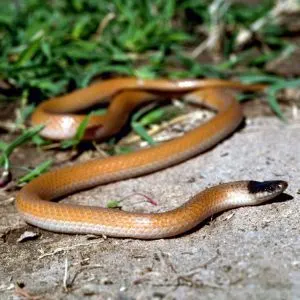
- Experience level: N/A
- Family: Colubridae
- Scientific Name: Tantilla nigriceps
- Other Names: N/A
- Adult Size: less than 12 inches
- Lifespan: Not recorded
- Average Price Range: N/A
Plains blackhead snakes can only be found in the southwest corner of the state. This fossorial species is completely tan or yellow with a black head.
Plains blackhead snakes make their home wherever soil is available. That means they can be found in prairies, grasslands, and woodlands. They prey on insects, centipedes, and spiders.
14. Plains garter snake
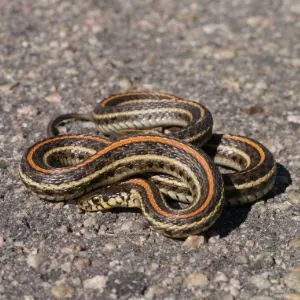
- Experience level: Beginner
- Family: Colubridae
- Scientific Name: Thamnophis radix
- Other Names: N/A
- Adult Size: 20-28 inches (50.8-71.12 centimeters)
- Lifespan: 10 years
- Average Price Range: $25-$45
Plains garter snakes can be found in prairies and wetlands across the state. The color of this snake is contingent on which part of Nebraska you’re in.
In the eastern part of the state, the ground color is red. In the west, the ground color is green. Different ground colors aside, all plains garter snakes have a yellowish stripe that goes down the back. They primarily feed on amphibians, fish, earthworms, and slugs.
15. Prairie kingsnake

- Experience level: Intermediate
- Family: Colubridae
- Scientific Name: Lampropeltis calligaster
- Other Names: N/A
- Adult Size: 32-46 inches (81.28-116.84 centimeters)
- Lifespan: 12-20 years
- Average Price Range: $200
The coloration of prairie king snakes varies from brown to green with darker blotches. The easiest way to identify a prairie kingsnake is by the V-shaped pattern atop its head.
This species resides only in the southeast corner of the state. As the name implies, they live in prairies. Prey mainly consists of voles.
16. Redbelly snake
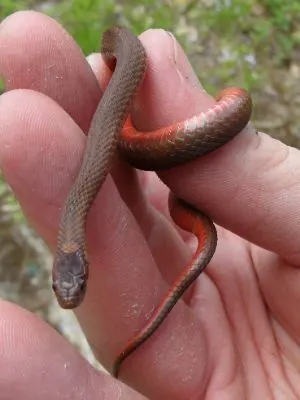
- Experience level: Intermediate
- Family: Colubridae
- Scientific Name: Storeria occipitomaculata
- Other Names: Fire snake
- Adult Size: 8-11 inches (20.32-27.94 centimeters)
- Lifespan: 4 years
- Average Price Range: $60
Redbelly snakes are usually gray, brown, or red on top with a red belly and three white spots on the neck.
Only seen in four counties (Buffalo, Dawson, Hall, and Phelps), redbelly snakes prefer environments they can hide in. Thus, moist woodlands with lots of logs and rocks are ideal. Their diet includes slugs, earthworms, and the occasional insect. Redbelly snakes are nocturnal.
17. Ringneck snake
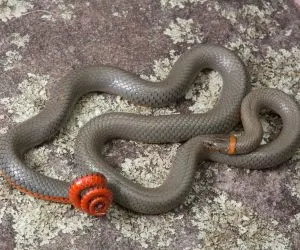
- Experience level: Intermediate to Expert
- Family: Colubridae
- Scientific Name: Diadophis punctatus
- Other Names: Corkscrew snake, thimble snake
- Adult Size: ~14 inches (35.56 centimeters)
- Lifespan: 10-20 years
- Average Price Range: $30
Ringneck snakes are typically bluish black or brownish gray with a bright orange or yellow ring around the neck. Their belly color matches the color of the ring.
These snakes can be found all over east Nebraska with the biggest population convening in the state’s southeast corner. Ringneck snakes will typically hang around woodland edges, grasslands, and even urban environments. Earthworms and small arthropods take up their entire diet.
18. Smooth green snake
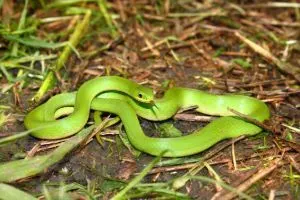
- Experience level: Intermediate to Expert
- Family: Colubridae
- Scientific Name: Liochlorophis vernalis
- Other Names: Grass snake
- Adult Size: 10-20 inches (25.4-50.8 centimeters)
- Lifespan: Up to 6 years
- Average Price Range: $50
One of the prettiest snakes in Nebraska, the pattern-less smooth green snake is entirely bright green with a yellow belly.
You can find one of these snakes virtually anywhere, however, recent spottings have come from Lincoln and Cuming counties. These smooth-scaled snakes are insectivores.
19. Speckled kingsnake
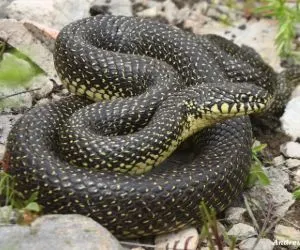
- Experience level: Beginner to Intermediate
- Family: Colubridae
- Scientific Name: Lampropeltis holbrooki
- Other Names: Salt and pepper snake
- Adult Size: 36-48 inches (91.44-121.92 centimeters)
- Lifespan: 10-20 years
- Average Price Range: $99-$200
The speckled kingsnake is bright colored with black speckles all over its body. Limited to five counties (Jefferson, Lancaster, Nebraska, Nemaha, and Pawnee), this species loves a wet prairie or a marsh.
They are also occasionally seen basking in the road. Speckled kingsnakes feed on other snakes, birds, lizards, and rodents.
20. Terrestrial garter snake

- Experience level: Beginner
- Family: Colubridae
- Scientific Name: Thamnophis elegans
- Other Names: N/A
- Adult Size: 20-30 inches (50.8-76.2 centimeters)
- Lifespan: 4-10 years
- Average Price Range: $25
The last of Nebraska’s garter snakes, the terrestrial garter snake resides in the Panhandle and Pine Ridge region of the state.
They’re normally brown, gray, or green with a light stripe that runs down the body. Dark blotches are also often present. Terrestrial garter snakes live along streams and other wetlands, making their diet a combination of fish and amphibians.
21. Western fox snake
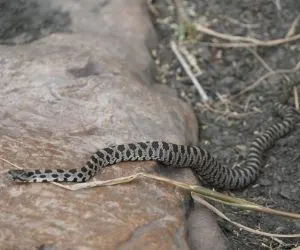
- Experience level: Intermediate
- Family: Colubridae
- Scientific Name: Pantherophis ramspotti
- Other Names: N/A
- Adult Size: 36-50 inches (91.44-127 centimeters)
- Lifespan: Up to 17 years
- Average Price Range: $170
The state’s only fox snake, the western fox snake lives in a variety of habitats (grasslands, woodlands, farmlands, savannas) in northeast Nebraska. This species is normally light brown or yellow with a row of darker blotches going down the back and a creamy checkerboard belly.
Like a rattlesnake, a western fox snake will often shake its tail, but don’t worry, they’re not venomous. They eat small mammals, small birds, and amphibians.
22. Western hognose snake
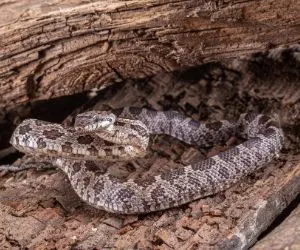
- Experience level: Beginner to Intermediate
- Family: Colubridae
- Scientific Name: Heterodon nasicus
- Other Names: Puff adder, hissing sand snake
- Adult Size: 15-25 inches (38.1-63.5 centimeters)
- Lifespan: 9-19 years
- Average Price Range: $150
Like its cousin in the eastern hognose snake, the western hognose snake also has an upturned snout. The western hognose is smaller than the eastern hognose and is almost always brown with darker blotches going down the course of its body.
Western hognoses live in the grasslands, prairies, and sandhills of west Nebraska. Their diet consists of frogs, toads, small birds, hatchling turtles, and eggs.
23. Western rat snake
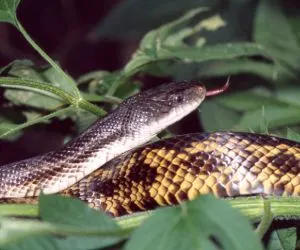
- Experience level: Intermediate to Expert
- Family: Colubridae
- Scientific Name: Scotophis obsoletus
- Other Names: Black rat snake, pilot snake
- Adult Size: 48-72 inches (121.92-182.88 centimeters)
- Lifespan: 10-15 years
- Average Price Range: $60
The western rat snake is completely black with tiny red blotches once adulthood is reached. Young western rat snakes look quite different, typically being gray with dark and red markings all over.
This species is limited to the southeast corner of the state and lives mainly in grasslands and woodlands. These rather large snakes feed on birds, small mammals, and rodents.
24. Western ribbon snake
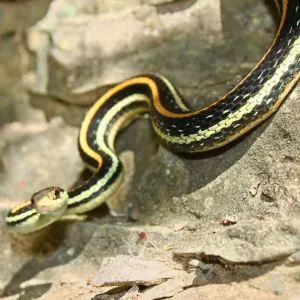
- Experience level: Beginner
- Family: Colubridae
- Scientific Name: Thamnophis proximus
- Other Names: N/A
- Adult Size: 17-50 inches (43-127 centimeters)
- Lifespan: 12-20 years
- Average Price Range: $40
Sometimes confused with a garter snake, the western ribbon snake is dark colored with a yellowish orange “ribbon” going down the middle of their back. They also have white stripes on their sides.
Also limited to the southeast corner of the state, western ribbon snakes love wet environments such as meadows, lake edges, and flooded ditches. They mostly eat fish and amphibians.
25. Western worm snake
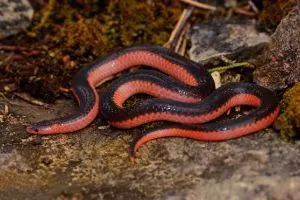
- Experience level: Beginner
- Family: Colubridae
- Scientific Name: Carphophis vermis
- Other Names: N/A
- Adult Size: 7-11 inches (17.78-28 centimeters)
- Lifespan: 4 years
- Average Price Range: $20
The western worm snake holds the title for smallest snake in Nebraska. It’s so small that it can’t even bite humans. This bicolored snake is dark on top with an orangish pink lower half.
The western worm snake lives in moist woodlands and hillsides in the southeast corner of the state and feeds on earthworms and insect larvae.
Venomous Snakes in Nebraska
26. Copperhead

- Experience level: Expert
- Family: Viperidae
- Scientific Name: Agkistrodon contortrix
- Other Names: Highland moccasin, rattlesnake pilot
- Adult Size: 28-36 inches (60.96-91.44 centimeters)
- Lifespan: ~18 years
- Average Price Range: $100
Only ever found in the hilly and wooded areas of two counties (Gage and Richardson), copperheads aren’t terribly populous in Nebraska.
They are normally brown, copper, or red with darker cross bands outlined in white. Copperheads subsist on small mammals, birds, amphibians, and other reptiles.
27. Massasauga
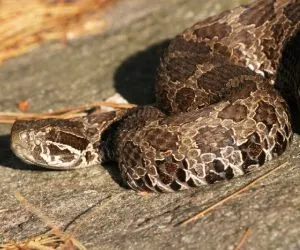
- Experience level: Expert
- Family: Viperidae
- Scientific Name: Sistrurus catenatus
- Other Names: Swamp rattler
- Adult Size: 28-36 inches (71.12-91.44 centimeters)
- Lifespan: Up to 14 years
- Average Price Range: $100
Protected in Nebraska, massasauga rattlesnakes are found sparingly in wetlands across the southeast corner of the state. These venomous snakes are gray or brown with darker blotches that form into crossbands going down the length of the body.
Massasaugas generally avoid human interaction. They mostly eat mice and voles.
28. Prairie rattlesnake

- Experience level: Expert
- Family: Viperidae
- Scientific Name: Crotalus viridis
- Other Names: Hopi rattlesnake
- Adult Size: 34-45 inches (86.36-114.3 centimeters)
- Lifespan: 16-20 years
- Average Price Range: $125
Also a resident of the state’s prairies, the venomous prairie rattlesnake is usually a light gray or brown with darker blotches traveling down the course of the body.
Found in the western half of the state, this snake will also frequent rocky mesas or canyons. They exclusively feed on small mammals.
29. Timber rattlesnake
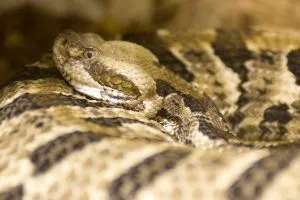
- Experience level: Expert
- Family: Viperidae
- Scientific Name: Crotalus horridus
- Other Names: Banded rattlesnake
- Adult Size: 36-60 inches (91-152 centimeters)
- Lifespan: 10-20 years
- Average Price Range: N/A
Timber rattlesnakes are tannish gold with black V-shaped or M-shaped crossbands. They also have a reddish-brown stripe that goes down the back.
Nebraska’s largest rattlesnake, this species can be located in the woodlands of the southeast corner of the state. They feed only on small mammals.
Frequently Asked Questions
Are there rattlesnakes in Nebraska?
There are three different rattlesnake species in the state of Nebraska: the prairie rattlesnake, timber rattlesnake, and the western massasauga.
Can you kill snakes in Nebraska?
Technically, you can kill a snake in the state of Nebraska, but it depends on the species as the Cornhusker State regulates the harvest of all reptiles and amphibians. Protected species that cannot be killed include the timber rattlesnake, prairie kingsnake, speckled kingsnake, and the western worm snake. Other than that, there is a bag limit of three per species.
What is the biggest snake in Nebraska?
The bullsnake is Nebraska’s largest snake, growing up to six feet long.
Can you own a snake in Nebraska?
Nebraska is one of a handful of states that does not regulate snake ownership, so yes, you can pretty much own any kind of snake in the state of Nebraska.
What venomous snakes live in Nebraska?
Outside of the three venomous rattlesnakes (prairie rattlesnake, timber rattlesnake, massasauga), the copperhead rounds out the group of four venomous snakes in Nebraska.
Conclusion
As you can tell, there are an abundance of snakes in Nebraska. Thank you so much for reading, and we hope this list helps you out—whether you’re looking to herp or for a new pet.
Take some time to comment below and discuss your favorite snake in Nebraska with fellow enthusiasts.
Snakes in other states
